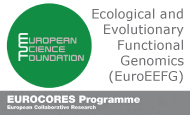Microbial Oceanography of ChemolithoAutrotrophic planktonic Communities (MOCA)
Microbial Oceanography of Chemolithoautotrophic Planktonic Communities (MOCA)
European Science Foundation - Eurocores Program EuroEEFG (Ecological and Evolutionary Functional Genomics) Funded by German Science Foundation (DFG) 2010-2013
Background
Simulation models predict that the oxygen content of the global ocean will decrease by 25% until the end of the century due to an increased stratification of the oceanic surface waters and a rise in temperature. This loss in oxygen will inevitably lead to an expansion of hypoxic (= reduced oxygen content) and anoxic areas (= areas depleted in oxygen) in the global ocean with major consequences for the oceanic carbon and nitrogen cycling. The potential impact of an expansion of oxygen minimum zones (OMZ) is probably best illustrated by their current role in the global ocean nitrogen (N) cycle. At present, about 30-50% of the nitrogen loss from the global ocean takes place in the 0.1% of ocean volume comprised of OMZ. Hence, OMZ disproportionally influence the nitrogen cycle and connected to that via autotrophy also the carbon cycle.
The Atlantic
While Planctomycetes-anammox strive only in waters with an oxygen content of less than 10 µM, remarkably high chemolithotrophic carbon fixation (roughly equaling the amount of heterotrophic picoplankton production) has been measured throughout the oxygenated water column of the Atlantic raising questions on the energy source of this dark ocean autotrophic archaeal and bacterial community. In the water underlying the euphotic zone, ammonia is present at fairly high concentrations resulting in intense nitrification activity of Thaumarchaeota (formerly known as Marine Crenarchaeota Group I (MCGI)) and beta- and gammaproteobacteria. However, in waters below the oxygen minimum zone, ammonia concentrations are in the low nanomolar range and hence, below the detection level using routine spectrophotometric methods. This, together with data on the genetic composition, suggests that thaumarchaeota are mainly heterotrophic or mixotrophic in the deeper waters.
The Baltic Sea
In the Baltic Sea, one of the largest brackish water systems on Earth, a suboxic zone is present similar to the oceanic OMZ, which harbors Thaumarchaeota as potential nitrifiers, and at lowest oxygen concentrations, also anammox bacteria. However, in the central Baltic Sea, an interface between nitrate and hydrogen sulfide occurs below the suboxic zone. Here, denitrification is fueled by the oxidation of reduced sulfur compounds and mediated by chemoautotrophic Epsilonproteobacteria. A characteristic feature of marine chemoclines seems to be that highest dark CO2 fixation rates are found in the upper sulfidic zone where neither oxygen nor nitrate can serve as electron acceptors. In the Baltic Sea, this chemoautotrophic production may account for up to 30 % of surface primary production. Although it could be shown that most of the CO2 fixing cells in the redoxclines of the Baltic and Black Sea, respectively, were Epsilonproteobacteria, the underlying redox reactions and metabolic pathways are not yet fully understood. Different lines of evidence (biogeochemical profiles, community analysis,experiments with cultured representatives) suggest that some of the chemoautotrophic guilds might in fact be mixotrophic, able to facultatively use organic carbon sources.
Taken together, there is evidence accumulating that chemolithoautrophy is more widespread in the oceanic water column than hitherto assumed, and not restricted to anoxic and hypoxic water bodies. This dark ocean autotrophy represents a fresh carbon source for the deep-water heterotrophic community. In the North Atlantic, this dark oceans ‘primary production’ amounts to about 20-40% of the export phytoplankton production and is in the same order of magnitude as the dark oceans heterotrophic picoplankton production. It is also noteworthy, that this dark ocean ‘primary production’ escapes estimates of the organic carbon flux, as these autotrophic picoplankton are non-sinking particles due to their micrometer size. Albeit this dark oceans autotrophy is substantial, the CO2 fixation in the oceans interior has thus far not taken into account in any oceanic carbon budget models. With the predicted global changes (increased stratification, accumulation of anthropogenic CO2, warming) affecting also the inner space of the ocean, the balance between hetero- and autotrophic picoplankton in the meso- and bathypelagic layers might also change. Despite the recent notion that lithoautotrophy might be of considerable importance in many marine systems, the mediators of this process, their energy requirements and metabolic pathways are largely unknown.
This project represents a concerted effort, combining recently acquired scientific knowledge and methodological advances made in the different participating laboratories, to shed light on one of the biggest microbiological and biogeochemical enigmas of the oceans interior, the extent of chemolithoautotrophy, the functional diversity and physiological adaptations of the lithotrophic prokaryotic community.
The overarching hypothesis is: The predicted loss in oxygen from the global ocean leads to major shifts in the nitrogen cycles and an increased importance of prokaryotic inorganic carbon fixation as a source of newly produced organic carbon, particularly in the deep waters, in oxygen minimum zones, and at oxic-anoxic interfaces in the water column.
Consequently, the main objective of the proposed study is to elucidate the dynamics in the functional diversity of the pelagic chemolithoautotrophic microbial community from oxygenated waters to anoxic conditions in geographically distant marine sites.
International Partners:
University of Vienna (Austria):
Prof. Gerhard Herndl
Dr. Eva Sintes
Kristin Bergauer
Simone Muck
Prof. Christa Schleper
Dr. Pierre Offre
University of Kalmar (Sweden):
Ass. Prof. Jarone Pinhassi
University of La Laguna (Spain):
Dr. José Gonzalez

